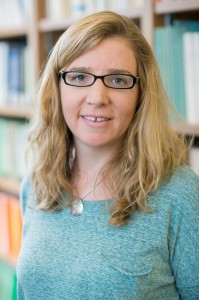Many people would welcome the idea of the four-day work week. But to write an entire Geography textbook from scratch in just four days? Challenge accepted, said Clint Lalonde and Amanda Coolidge, Managers of Open Education at BCcampus.
From 9-12 June, a team of five authors (Britta Ricker and Cristina Temenos from SFU, Aviv Ettya from UFV, Siobhán McPhee from UBC and Arthur “Gill” Green from UBC Okanagan) became part of BCcampus’s first ever Open Textbook Sprint, under the watchful eye of moderator Barbara Ruehling from BookSprints. Clint and Amanda’s team also included illustrator Hilda Anggraeni, programmer Brad Payne and UBC librarian Jon Strang.
On Monday 9 June at 8:30am the team were all introduced to one another, and almost 50,000 words later, at 8:30pm the following Thursday, they had a finished Geography first-year textbook.
To begin with, why was Geography chosen as the subject area?
“Whilst Geography is one of the Top 40 subject areas in BC, there are currently no existing textbooks on regional BC geographic sites,” Clint explains.
“We’ve been able to incorporate a lot of existing case studies, referring to many sites and historical events (such as 1960 Port Alberni tsunami). A key feature of online textbooks is that we’re also able to include such components as interactive mapping.”
The free and complete textbook will be available in August 2014 for downloading at http://open.bccampus.ca, but “complete” is not strictly correct: the Creative Commons Attribution (CC-BY) license means that facilitators and tutors can freely further adapt and modify the text, and insert additional information to fit specific learning content.
“We hope that others will take this textbook even further.” Amanda adds.
“Besides the interactive maps, we’ve also been able to incorporate Service Learning activities, resulting from field work by Geography students, who’ve in turn contributed their own mapping work, illustrations and Wikipedia content.”
“It was also extremely useful to have Barbara as a moderator,” Clint continues. “Because this is the first time we’ve done this, having an impartial outsider to keep everyone on track made it an even better collaborative exercise.”
Were the days scheduled (i.e. with set “break times”) or was the schedule a little more flexible?
“Barbara would go by the “feel” of the room,” Clint replies. “If the ideas were flowing freely, she’d aim to stay in this mode as long as possible, breaking when convenient. We arranged to have all meals brought in, which is useful when you’re working 12-14 hour days!”
“It’s perhaps been more of a marathon than a sprint,” Amanda agrees. “However, it’s amazing what you can accomplish in a short time. You have to really focus in on the task in order to find the most quality in the resources you have; there’s no time to “hum and haw”.”
And if they were to undertake this exercise again?
“Yoga tables and massages were one request from participants,” laughs Clint.
“I think next time we’d like to have even one or two additional authors. It was also incredibly useful to have librarian Jon Strang’s services for two days – he was able to assist us with Wi-Fi connections and could contact authors directly in order to obtain copyright permission. Due to his busy schedule we were so fortunate to have his services for two days – we would have happily kept him the entire time if we could!”
UBC’s Siobhán McPhee, a Geography Instructor/Lecturer, echoes the praise for Jon, Barbara and the other support staff involved.
Participating for the first time in both the creation of a “textbook sprint” and an online textbook, and speaking with me on the Friday immediately after its completion, she admits it was “exhausting, both physically and mentally” but that as a self-confessed “eternal student” the positives far outweighed the negatives.
“I learned so much, about copyright, online teaching and learning and about collaborative work – I love working with people on anything from digging a hole to writing a textbook – but this was the first time I’ve worked with strangers as opposed to friends and colleagues,” she says.

Siobhán McPhee
Siobhán also relishes the “clutter-free” environment and widely-accessible linking of resources that an online textbook provides, and mentions that as a free resource, they are “a real equalizer” amongst students.
I mention that personally, I would have found it challenging to criticize/challenge the work of strangers, with a (likely false, but surely common) fear of causing offence. Did she feel similarly at all?
“During the first two days, perhaps,” Siobhán admits. “But by day three, everyone knew each other’s strengths and weaknesses, and we felt comfortable to more freely discuss who should cover what section.”
Clint and Amanda are full of praise for their team, and their obvious enthusiasm for both their work and their students.
“We were just so impressed with everyone who was involved: clearly they care very deeply.” Amanda said.
The project naturally generated plenty of interest from outside institutions and educators, with many requests to “drop in” and view the work in progress, but Amanda and Clint were able to keep everyone updated via blog posts at http://open.bccampus.ca/tag/booksprint/ and the Twitter hashtag #bcbooksprint.
Siobhán plans to use her new found knowledge to undertake an upcoming “sprint day” with her students, where they will be designing a geography field school from 10am-4pm. Amongst her many current projects she is also developing a 4th year course on Geography in the Middle East, which will feature a very strong online open access component.
The authors plan to publish the textbook under the title of “Geography Open Textbook Collective”. As well as being available as an open learning resource, the textbook is available in PDF, ePub, and HTML formats for WordPress, and also for print on demand in hard copy. Visit http://open.bccampus.ca for more details.



